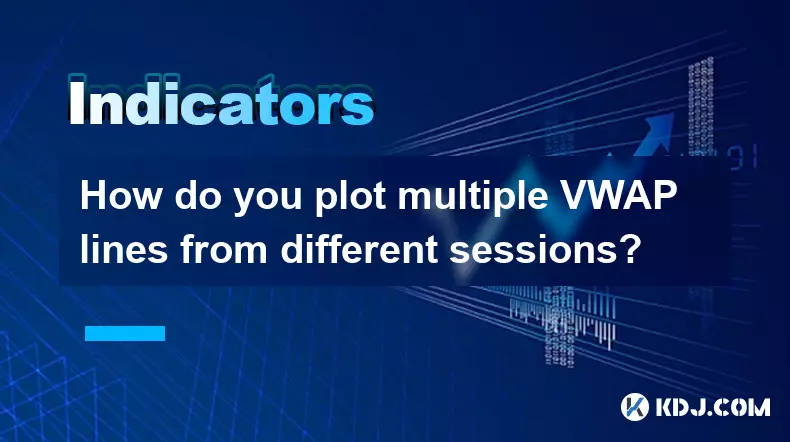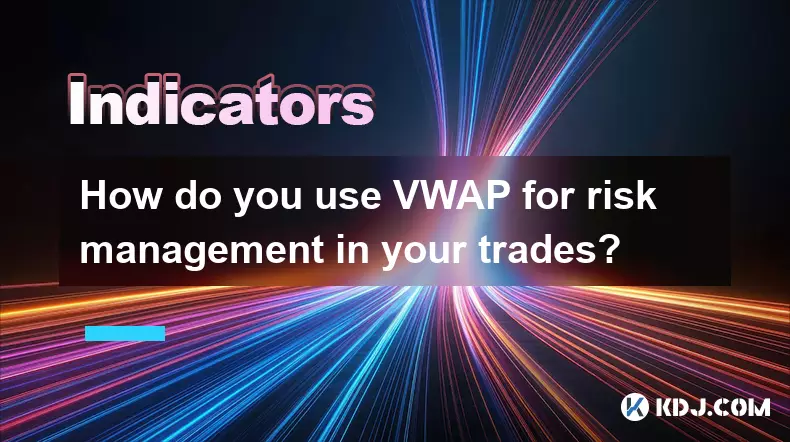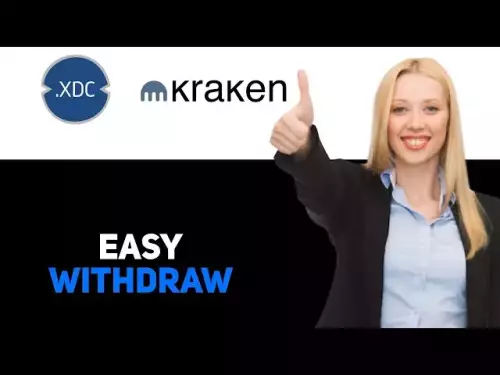-
 bitcoin
bitcoin $114684.631706 USD
-0.87% -
 ethereum
ethereum $4228.677447 USD
1.58% -
 bnb
bnb $1294.880693 USD
-1.16% -
 tether
tether $1.000819 USD
-0.02% -
 xrp
xrp $2.605138 USD
2.79% -
 solana
solana $209.908690 USD
5.89% -
 usd-coin
usd-coin $0.999903 USD
-0.03% -
 dogecoin
dogecoin $0.213423 USD
2.93% -
 tron
tron $0.322721 USD
-0.10% -
 cardano
cardano $0.727247 USD
3.66% -
 hyperliquid
hyperliquid $42.339456 USD
6.05% -
 chainlink
chainlink $19.910811 USD
5.16% -
 ethena-usde
ethena-usde $1.000557 USD
0.00% -
 stellar
stellar $0.349734 USD
2.69% -
 bitcoin-cash
bitcoin-cash $543.848687 USD
-0.21%
How do you plot multiple VWAP lines from different sessions?
Traders use multi-session VWAP to analyze price trends across different trading hours, comparing volume-weighted averages to spot shifts in momentum and sentiment.
Oct 14, 2025 at 07:36 am

Understanding VWAP Across Different Trading Sessions
1. Volume Weighted Average Price (VWAP) is a critical benchmark used by traders to assess the average price of an asset weighted by volume over a specified period. While most platforms calculate VWAP from the beginning of a single session, plotting multiple VWAP lines from different sessions requires deliberate configuration and tools that support custom session definitions.
2. To achieve this, traders must use advanced charting software such as TradingView, NinjaTrader, or ThinkorSwim, which allow customization of timeframes and session boundaries. These platforms enable users to define pre-market, regular market, post-market, or even arbitrary intervals as distinct trading sessions.
3. Each session’s VWAP is calculated independently using the formula: (Cumulative (Price × Volume)) / Cumulative Volume. By isolating volume and price data within user-defined session windows, the system computes a unique VWAP line for each interval.
4. Traders often overlay VWAPs from previous days or alternate sessions (e.g., Asian, European, U.S.) to compare intraday momentum against historical benchmarks. This comparative analysis helps identify deviations in current price behavior relative to prior volume-driven equilibrium levels.
Setting Up Multiple VWAP Instances on Charting Platforms
1. In TradingView, users can apply multiple instances of the built-in VWAP indicator and modify their settings to restrict calculations to specific time ranges. For example, one instance may be limited to 9:30 AM–4:00 PM ET (U.S. regular session), while another covers 4:00 PM–8:00 PM ET (extended-hours session).
2. Script-based solutions using Pine Script allow precise control over session logic. A custom script can detect session start times, reset cumulative values at session boundaries, and plot separate VWAP curves with distinct colors or styles for clarity.
3. On NinjaTrader, the Market Analyzer or SuperDOM can integrate multi-session VWAPs when paired with a C# indicator that resets based on session time filters. Users define session templates under “Instrument” settings, then reference them in the VWAP calculation loop.
4. ThinkorSwim offers a feature called “Reset Time” within its VWAP study, allowing selection of daily, weekly, or custom resets. Applying several VWAP studies with different reset points effectively generates overlapping lines representing various sessions.
Practical Applications of Multi-Session VWAP Analysis
1. Institutional traders monitor extended-hours VWAPs to evaluate off-session liquidity absorption and anticipate gaps at the open. A significant deviation between pre-market VWAP and regular-session VWAP may signal aggressive positioning ahead of new information flow.
2. Divergence between session-specific VWAP lines can highlight shifts in market sentiment across global trading zones. For instance, if the Asian session VWAP shows strong buying pressure but the European session VWAP flattens despite rising volume, it suggests waning follow-through from later participants.
3. Algorithmic strategies incorporate multiple VWAP references to determine execution priority. An order might aim to buy below the prior day’s VWAP while selling above the current session’s VWAP, leveraging inter-session value zones.
4. During news events or earnings releases outside regular hours, having a dedicated VWAP for the announcement window provides a fair valuation metric unaffected by earlier session dynamics.
Technical Considerations When Plotting Multiple VWAPs
1. Accurate timestamp alignment is essential, especially when dealing with exchanges operating in different time zones. Misaligned session boundaries due to daylight saving changes or incorrect timezone settings can distort VWAP calculations.
2. Data granularity impacts precision—using tick-level or minute-level data ensures accurate volume aggregation at each bar, preventing distortion in high-frequency environments.
3. Overlapping VWAP lines should be visually differentiated through color coding, line thickness, or dash patterns to prevent confusion during fast-moving markets.
4. Some platforms limit the number of concurrent indicators or impose performance penalties when running multiple script-based VWAPs, particularly on lower-end hardware or browser configurations.
Frequently Asked Questions
Can VWAP be recalculated retroactively for past sessions?Yes, provided that complete historical tick or bar data including volume is available. Most professional-grade data feeds retain sufficient detail to reconstruct VWAP for any defined session retrospectively.
Is it possible to have VWAP reset at non-standard intervals like every 4 hours?Absolutely. Custom scripts in platforms like TradingView or NinjaTrader can enforce VWAP resets at fixed intervals regardless of traditional market hours, enabling crypto traders to analyze 4-hour blocks aligned with blockchain batch cycles.
Do all brokers provide access to multi-session VWAP tools?No. Access depends on the brokerage's platform capabilities. Retail-focused brokers may offer only basic VWAP, whereas institutional platforms typically support advanced session segmentation and scripting for complex VWAP configurations.
Disclaimer:info@kdj.com
The information provided is not trading advice. kdj.com does not assume any responsibility for any investments made based on the information provided in this article. Cryptocurrencies are highly volatile and it is highly recommended that you invest with caution after thorough research!
If you believe that the content used on this website infringes your copyright, please contact us immediately (info@kdj.com) and we will delete it promptly.
- XRP Price Prediction: Weekend Rollercoaster or Rally?
- 2025-10-12 08:45:16
- Bittensor (TAO): Super Bullish Signals Point to Potential 2x Rally
- 2025-10-11 10:25:12
- Silver Price Correction: Navigating the Dip & Identifying Key SEO Keywords
- 2025-10-11 10:25:12
- Decoding Crypto Trends: Bittensor's Bull Run, Cardano's Dip, and LivLive's Presale Buzz in 'Uptober 2025'
- 2025-10-12 08:45:16
- MoonBull: The Crypto Meme Coin Promising 1000x Gains?
- 2025-10-11 10:30:01
- Crypto Payroll Revolution: Stablecoins, Altcoins, and the Future of Salary Payments
- 2025-10-11 10:30:01
Related knowledge

What's the main difference between VWAP and TWAP?
Oct 12,2025 at 11:54am
Understanding VWAP and Its Role in Crypto Trading1. Volume Weighted Average Price (VWAP) is a trading benchmark that calculates the average price of a...

How do you identify exhaustion moves using VWAP and its bands?
Oct 12,2025 at 08:00am
Understanding the Role of Decentralized Exchanges in Crypto Trading1. Decentralized exchanges (DEXs) operate without a central authority, allowing use...

How do you use VWAP to scale in and out of positions?
Oct 14,2025 at 02:19am
Understanding VWAP as a Dynamic Benchmark1. The Volume Weighted Average Price (VWAP) is not just an indicator—it functions as a dynamic benchmark that...

What are the main advantages of using VWAP over EMA?
Oct 11,2025 at 02:18am
Main Advantages of Using VWAP Over EMA1. Volume-Weighted Average Price (VWAP) incorporates trading volume into its calculation, offering a more accura...

How do you use VWAP on different chart types like Heikin Ashi?
Oct 11,2025 at 05:01pm
Understanding VWAP in the Context of Heikin Ashi Charts1. The Volume Weighted Average Price (VWAP) is a powerful analytical tool commonly used by trad...

How do you use VWAP for risk management in your trades?
Oct 11,2025 at 02:54am
Understanding VWAP as a Dynamic Benchmark1. The Volume Weighted Average Price (VWAP) serves as a crucial reference point in intraday trading by reflec...

What's the main difference between VWAP and TWAP?
Oct 12,2025 at 11:54am
Understanding VWAP and Its Role in Crypto Trading1. Volume Weighted Average Price (VWAP) is a trading benchmark that calculates the average price of a...

How do you identify exhaustion moves using VWAP and its bands?
Oct 12,2025 at 08:00am
Understanding the Role of Decentralized Exchanges in Crypto Trading1. Decentralized exchanges (DEXs) operate without a central authority, allowing use...

How do you use VWAP to scale in and out of positions?
Oct 14,2025 at 02:19am
Understanding VWAP as a Dynamic Benchmark1. The Volume Weighted Average Price (VWAP) is not just an indicator—it functions as a dynamic benchmark that...

What are the main advantages of using VWAP over EMA?
Oct 11,2025 at 02:18am
Main Advantages of Using VWAP Over EMA1. Volume-Weighted Average Price (VWAP) incorporates trading volume into its calculation, offering a more accura...

How do you use VWAP on different chart types like Heikin Ashi?
Oct 11,2025 at 05:01pm
Understanding VWAP in the Context of Heikin Ashi Charts1. The Volume Weighted Average Price (VWAP) is a powerful analytical tool commonly used by trad...

How do you use VWAP for risk management in your trades?
Oct 11,2025 at 02:54am
Understanding VWAP as a Dynamic Benchmark1. The Volume Weighted Average Price (VWAP) serves as a crucial reference point in intraday trading by reflec...
See all articles

























![[4K 60fps] Prisma by novichokk (1 Coin) [4K 60fps] Prisma by novichokk (1 Coin)](/uploads/2025/10/14/cryptocurrencies-news/videos/k-fps-prisma-novichokk-coin/68ee49804ba00_image_500_375.webp)
















































